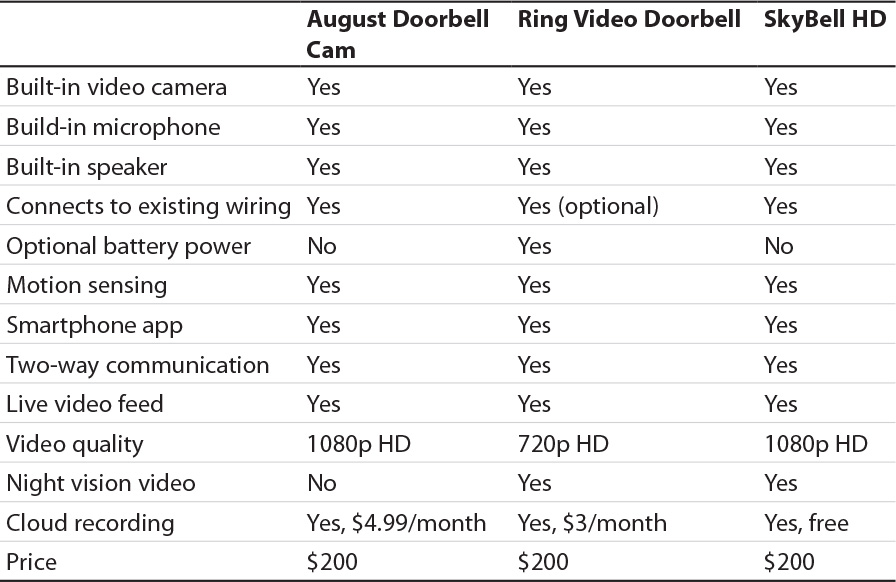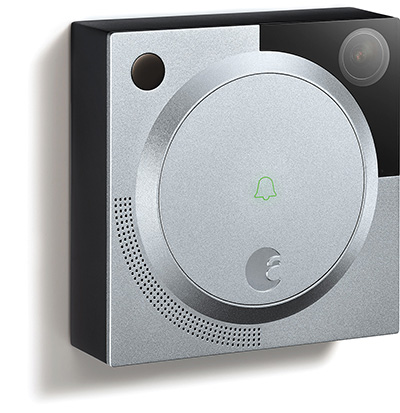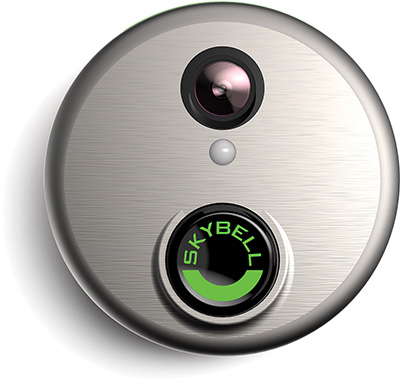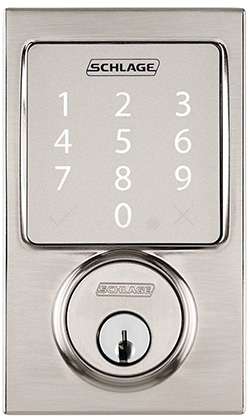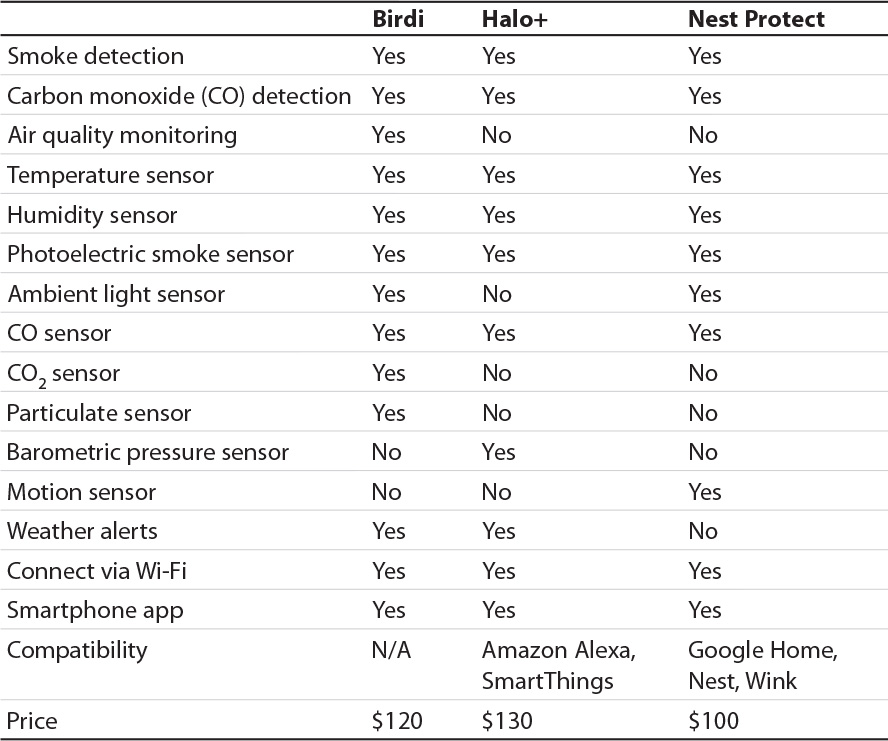5. Automating Home Security

In this chapter, you learn how to make your home safer with smart home technology.
How safe is your house or apartment? When the doorbell rings, do you know who’s at the door? Did you remember to lock your door when you left home? Do you know what’s happening on the other floors or rooms of the house? What happens if there’s smoke, or a fire? And how safe are you from break-ins, anyway?
We’re all concerned about our personal safety. Fortunately, smart home technology can actually make your home safer. There’s a variety of smart devices you can employ, from smart doorbells and door locks to whole-house security systems. You can choose the level of security that’s best for you.
Adding a Smart Doorbell
You’re sitting on your couch or lying in bed when the doorbell rings. You’re not expecting any visitors, and you don’t know whether you should get up to answer the door. Is it someone you know? Is it a delivery person with a package? Is it someone asking for donations? Or is it a bad guy who’s thinking of breaking in?
Wouldn’t it be great to know who’s at the door before you open it—or even got up out of bed? Well, you can do just that when you install a smart doorbell outside your front door. When someone presses the button on a smart doorbell, you can see who’s there without getting up and walking across the room. That’s a safer and more convenient solution.
How Smart Doorbells Work
Most smart doorbells operate in a similar fashion. The doorbell installs outside your front door, replacing your current doorbell. Some connect to your existing doorbell’s wiring for power and chime inside your house; some have their own built-in batteries for power without involving any wiring. (These latter types are ideal if you live in an apartment and can’t replace the existing doorbell.)
All smart doorbells have built-in video cameras. So when someone presses the doorbell button, not only do you hear a chime letting you know someone’s at the door, you also get a notification on the doorbell’s mobile app. Just tap the button on your smartphone or tablet and you see, in real time, who’s at your front door. You can then decide whether you want to get up and let them in.
Some smart doorbells have a built-in speaker and microphone, so you can talk to and hear whoever’s at your door. And, thanks to the Internet, you can see who’s at the door (and talk with them) when you’re not at home; that way it can look like you’re at home even if you’re hundreds of miles away.
There are several popular models of smart doorbells available today. This chapter examines the three most popular, as detailed in Table 5.1.
As you can see, all three of these popular models sell for around $200 and offer similar features. Because of its built-in battery, however, the Ring Video Doorbell is the easiest of the three to install, and really the only choice if you live in an apartment where you can’t tamper with the existing doorbell wiring.
August Doorbell Cam
The August Doorbell Cam is a small round device that replaces your existing doorbell. Like the other smart doorbells discussed here, it includes a built-in HD video camera, microphone, and speaker, so you can see, hear, and talk to anyone at your front door. It also includes a motion sensor so you’re alerted if someone’s knocking instead of ringing (why do people do that?), or if someone suspicious is hanging around your front door.
The August Doorbell Cam
Like the other smart doorbells here, you get alerted in two ways when someone pushes the doorbell button. First, your existing doorbell chime makes its sound, just as your current doorbell does. Second, you get an alert on the August smartphone app. This way you’re alerted to activity even when you’re not at home.
At this point you can choose to ignore the doorbell, get up and answer the door, or open the smartphone app to see who’s at the door. This last option is the safest and most useful; if it’s someone you don’t want to see, you can then ignore them.
When you’re using the smartphone app, you also have the option of talking to the person at the door. You see and hear the person, via the doorbell’s camera and microphone; they hear you but don’t see you, which is an added layer of protection. And, since you’re doing all this over the Internet, you can talk to someone at your door even when you’re at work, out for dinner, or on vacation. (This is especially useful for making people think you’re at home when you’re really not!)
The feature that makes the August doorbell unique is that it interfaces with August’s smart door lock, which is covered later in this chapter. By connecting the two August products together, you can opt to unlock the door if it’s someone you trust—again, even if you’re not at home. Let’s say, for example, that you have a housecleaning service. The cleaning lady rings the August doorbell, you see who it is on the August smartphone app, and then tell the person you’re unlocking the door. You do just that by tapping the button in the August app that unlocks the August door lock. Pretty nifty!
The August doorbell keeps a record of all operations, so you know when your doorbell is being rung (or when there’s been motion at the front door). All interactions are recorded by the doorbell’s camera, and you can call up past recordings at will—if you subscribe to August’s cloud recording service, that is. That costs $4.99 per month.
As to price, expect to pay around $200 for the August Doorbell Cam. Learn more at www.august.com.
Ring Video Doorbell
The Ring Video Doorbell is different from the other models discussed here in two ways. First, it isn’t round; it’s rectangular. Second, it doesn’t have to use your existing doorbell’s wiring for power. (Although it can, if you want.) It includes a built-in rechargeable battery, which makes it a better choice if you live in an apartment or condo where you can’t remove the existing doorbell.

The Ring Video Doorbell
A single battery charge should last between 6 and 12 months. You recharge the unit by removing the Ring doorbell from its mounting plate (loosen two screws and it lifts off) and connecting it to a power outlet via the supplied USB cable.
Aside from those two features, you get pretty much the same functionality as with the August and SkyBell models. There’s an HD video camera, microphone, and speaker, as well as night vision and motion-sensing technologies. You receive alerts on your smartphone (via Ring’s mobile app) when someone rings the bell or there’s motion at the front door; you can then view what’s happening via the doorbell’s built-in camera and microphone, and talk with the person at the door if you want.

Viewing a visitor on Ring’s smartphone app
The Ring app records and stores (in the cloud) all the interactions at your front door, so if you miss an alert you can go back and see who or what was there. (My Ring doorbell’s motion sensor caught me shoveling snow from my doorstep a few weeks ago!) Ring charges $3/month (or $30/year) for its cloud recording service.
If you connect the Ring doorbell to your existing doorbell’s wiring, you hear the doorbell through your existing system’s chime. If you use the Ring doorbell with its built-in battery, you probably want to purchase the optional Chime or Chime Pro. These devices connect to a power outlet and your Wi-Fi network, and ring when someone presses the button on your Ring doorbell. (They can also be configured to sound a different alert when the motion detector is activated.) The basic Chime unit sells for $30; the Chime Pro also functions as a Wi-Fi extender (nice if your front door is a far distance from your wireless router) and sells for $50.

Ring’s Chime Pro
Like the smart doorbells discussed here, the Ring Video Doorbell sells for around $200. Learn more at www.ring.com.
Ring Video Doorbell Pro
Ring also offers the Video Doorbell Pro. This model sells for about $50 more than the standard model and offers slightly better video recording, at full 1080p HD. (The regular Video Doorbell only offers 720p HD—which is more than adequate for viewing on your smartphone.) In addition, the Video Doorbell Pro does not have a built-in battery, so it only installs as a replacement for an existing doorbell.
SkyBell HD Wi-Fi Video Doorbell
Like the August Doorbell Cam, the SkyBell HD Wi-Fi Video Doorbell is a round device with a round button. It contains an HD video camera, microphone, and speaker. It connects to your existing doorbell wiring and has its own smartphone app.
The SkyBell HD Video Doorbell
When someone rings the SkyBell HD, you get a sound from your existing doorbell chimes as well as an alert on the SkyBell app. You can get up to answer the door (or not) or view who’s at the door on your phone. You can also talk to the person at the door via the mobile app, if you want.
Unlike the August doorbell (but like the Ring), the SkyBell HD has night vision technology to make it easier to view visitors after dark. You can also opt to just turn on the SkyBell camera to monitor what’s happening outside your front door. All video interactions are recorded and stored in the cloud for future viewing; unlike the other systems discussed here, SkyBell’s cloud recording service is free of charge.
The SkyBell HD sells for around $200. Learn more at www.skybell.com.
Installing a Smart Door Lock
Knowing who’s at your door is one thing. Being able to lock or unlock your door remotely is another.
Welcome to the world of smart locks. A smart lock replaces some or all of your existing deadbolt lock and offers a number of useful features. Some smart locks let you unlock the front door with a touch, or just by being near. Others let you lock or unlock your door with a smartphone app, even when you’re not at home. And some even interface with your other smart devices—such as a smart doorbell—to automatically lock or unlock your door when certain conditions are met.
How Smart Door Locks Work
When we talk about smart locks, there’s a lot of variety. The term “smart lock” is a fairly broad definition for number of different smart features that you might find on these products.
What they all have in common is that they replace some or all of your existing deadbolt lock. That means a bit of work to do the installation, which you may or may not be comfortable with. If you’ve never installed a lock before, you might want to hire a locksmith or handyman to do the job.
Almost all smart locks let you lock or unlock your door without using a traditional key. Some offer a touchscreen or touchpad you use to tap in a keycode for entry. Others connect to a special key fob or your smartphone via Bluetooth, and they lock or unlock with a touch of your finger or just when you’re physically close enough. (Most also let you use a physical key for backup, if you want.)
Then there’s remote operation. Some smart locks connect directly to your home Wi-Fi network so that you can operate them via smartphone app wherever you have an Internet connection. Others offer this type of Wi-Fi connectivity only when you purchase an additional bridge unit; the lock connects to the bridge via Bluetooth then the bridge talks to your smartphone via Wi-Fi.
A smaller number of smart locks use either Bluetooth or Wi-Fi to connect to other smart systems or devices. Some smart locks connect to Apple’s HomeKit, some to Nest products, and others to Wink hubs and devices. In addition, some smart locks connect to other devices sold by the same company. (The August Smart Lock works seamlessly with the August Video Doorbell, for example.)
Prices range anywhere from $200 to $350 for the smart lock itself, and an additional $100 or so for the optional Wi-Fi bridge, if necessary.
There are several different smart door locks available today. This chapter covers some of the most popular, as detailed in Table 5.2.
August Smart Lock
Let’s start with the August Smart Lock. This is a good choice if you’re using the August Video Doorbell, discussed previously in this chapter. These two devices work together to let you remotely unlock the door if whomever rings the bell is someone you want to see.
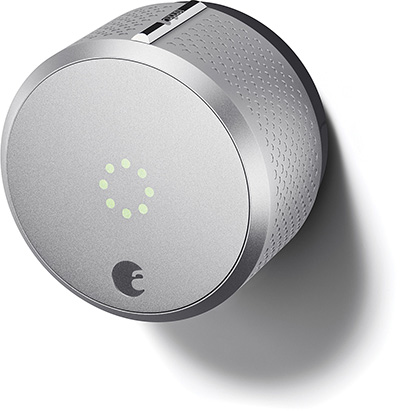
The August Smart Lock
The August Smart Lock uses Bluetooth technology to connect to your smartphone when you approach the front door. When configured to do so, it senses when you’re near and automatically unlocks the door; you don’t have to physically touch or tap or turn anything. It also senses when you leave via the front door and automatically locks itself after you.
You can also create virtual keys for family and guests. You create a limited-time electronic key and send it to a person’s smartphone via email. They then use their phone to unlock the door. (You can track their comings and goings via the August smartphone app, too.)
Rental Guests
August’s virtual keys are perfect for when you have guests visiting, or need to let in a repair person if you’re away from home. It’s also great if you offer your home as an Airbnb vacation rental—just send each guest their own limited-time keys to use.
The one truly unique feature of the August Smart Lock is that it doesn’t require you to replace your entire existing lock. You leave the outside part of your lock and the deadbolt in place and install the August lock in place of the inside portion of your lock. It’s the easiest installation of all these smart locks, and perhaps the only one suited for installation in apartments.

Installing the August Smart Lock
To take advantage of remote locking features, you need to purchase the optional August Connect device. This diminutive unit connects to your August lock via Bluetooth, and then to your home network (and the greater Internet) via Wi-Fi. It sells for about $80.
In addition, the August Smart Lock is compatible with Apple’s HomeKit. This means you can operate it via the Home app on your iPhone or iPad, or via Siri voice commands. It’s also compatible with the Google Home voice-controlled device.
The August Smart Lock sells for around $230. Learn more at www.august.com.
August Smart Keypad
August also makes a Smart Keypad that lets visitors unlock the smart lock by punching in a preprogrammed numeric code. This is good if you have repair people or house cleaners who need access to your home while you’re away; just give them a one-time code so they can enter.
Kwikset Kevo
Kwikset offers two different types of smart locks. First is the Kevo, which is currently in its second generation.
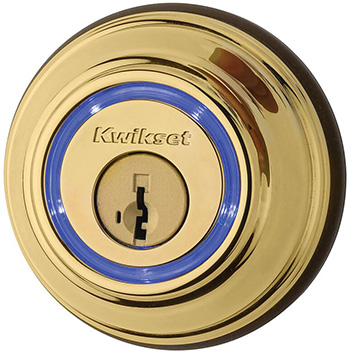
Kwikset’s Kevo smart lock
The Kevo totally replaces your existing deadbolt lock. When you approach your front door from the outside, all you have to do is touch the Kevo to unlock it. (That’s assuming you have either your smartphone or a Kevo key fob in your pocket; they have to connect to the Kevo lock via Bluetooth for this whole thing to work.) You can also unlock the door via Kevo’s smartphone app or a standard key.
You can also send virtual electronic keys to others to use with their smartphones. This lets anyone you approve unlock the front door just by touching the Kevo lock.
Kevo works with a variety of smart devices, including Honeywell thermostats, the Nest Learning Thermostat, the Ring Video Doorbell, and the SkyBell HD smart doorbell. It also functions with IFTTT commands.
IFTTT
IFTTT (If This Then That) is a cloud-based service for automating multiple smart devices. Learn more in Chapter 14, “Adding More Functionality with IFTTT.”
To work with these other devices, or to enable remote locking/unlocking, you need to purchase the Kevo Plus hub. This hub connects your Kevo to the Internet and lets you do all sorts of remote access and monitoring. It runs around $100.
The Kevo smart lock itself sells for around $230. Learn more at www.kwikset.com/kevo.
Kwikset Premis
Kwikset offers another smart lock, called the Premis Touchscreen Smart Lock. This lock’s claim to fame is that it’s compatible with Apple’s HomeKit system and Siri voice-controlled assistant.
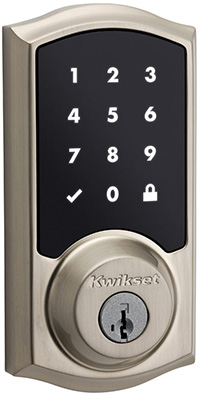
Kwikset’s Premis Touchscreen Smart Lock
Unlike its Kevo cousin, the Premis includes a touchscreen you can use to manually key in a code for entry. Otherwise, you use your phone to do the locking and unlocking. You can use the Premis mobile app, Apple’s Home app, or just talk to Siri and tell her to lock or unlock the door.
To work with Apple HomeKit, you need some sort of Apple hub—either an Apple TV set top box or an iPad that you keep inside your home. Unfortunately, the Premis is an Apple-only smart lock; there’s no Premis app for Android devices.
The Premis smart lock sells for around $230—the same price as the Kevo. Learn more at www.kwikset.com/premis.
Schlage Connect
Schlage is one of the leading lock makers in the world, and the Connect is its lead smart lock.
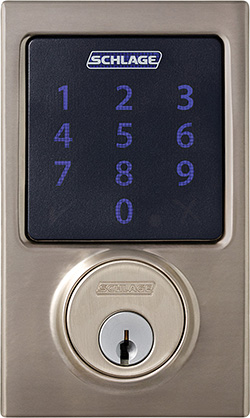
The Schlage Connect
The Connect isn’t as smart as some other smart locks, however. You can’t open it at your door with your smartphone or a key fob; you have to manually key in an entry code via its touchscreen control. You can, however, connect it to your Amazon Echo device and control it via voice commands to the Alexa personal assistant. It does connect to Z-Wave-compatible smart systems, such as the SmartThings and Wink hubs, so you can use those systems (and their smartphone apps) to control it remotely.
The Schlage Connect sells for $230 or less at most retailers. Learn more at www.schlage.com.
Schlage Sense
The Schlage Sense is similar to the Schlage Connect in that it offers a touchscreen for keying in manual entry. Unlike the Connect, the Sense is compatible with Apple’s HomeKit, so you can use your iPhone to open the door, either via the Home app or Siri voice commands. You can also assign virtual keys to guests’ iPhones.
The Schlage Sense
If you have an Apple TV or iPad in your home, you can use Apple’s HomeKit to control your lock remotely via your iPhone. Unfortunately, this is an Apple-only device, so it doesn’t work with Android devices.
The Schlage Sense sells for around $230. Learn more at www.schlage.com.
Yale Assure Lock with Bluetooth
Our final smart lock is the Yale Assure Lock with Bluetooth. It’s a keyless lock that you operate solely via your smartphone or its built-in touchpad.
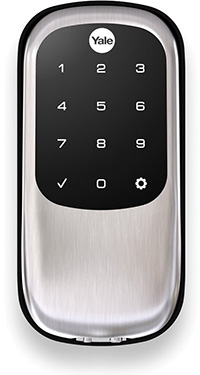
Yale’s Assure Lock
To lock or unlock the Assure, hold your phone up to the lock and make a key-like twisting gesture. The connection is via Bluetooth, of course. You can hand out virtual keys for friends or guests to use with their smartphones. Friends and guests (and you, too) can also unlock the Assure by keying in a code on the built-in touchpad.
Yale’s Assure integrates with any ZigBee or Z-Wave-compatible system, which includes SmartThings and Wink hubs and devices. It’s also slated to be compatible with Apple’s HomeKit in the near future.
To work with these smart systems, you need to invest in a Yale Network Module. This device serves as a bridge between the Bluetooth-enabled Assure lock and your smart system’s Wi-Fi hub. It sells for $75.
The Yale Assure Lock sells for around $200. Learn more at www.yalehome.com.
Using Smart Security Cameras
You can add another level of security to your home by installing indoor and/or outdoor security cameras. Smart security cams broadcast what they’re seeing to an accompanying smartphone app; some even connect to your existing smart home network to trigger other devices and events.
How Smart Cameras Work
A smart camera is more or less a standard video camera that connects to the Internet and offers remote viewing capability via the accompanying smartphone app. Some smart cameras also connect to your smart home hub to interface with other smart devices.
Smart cameras are a lot smaller than the traditional video cameras or security cameras you might be used to. Some of them resemble the smallish webcams you can add on to your desktop computer system. Others, designed for outside use, are in slightly larger housings for protection from the elements.
What most smart cameras have in common is the ability to operate in always-on mode or to be triggered by motion in the room or area. This type of motion detection can also alert you that there’s someone nearby and show you what’s happening.
In terms of connecting a smart camera, you don’t have to worry too much about cables and wiring. Most operate off of built-in rechargeable batteries, and they connect to your home network (and other devices) via Wi-Fi, so everything’s wireless.
These smart cameras also record everything they see, and upload the videos to the manufacturer’s cloud storage system. You’ll probably pay a small monthly fee for this service, but it lets you review what was recorded in the past.
This section covers a few of the most popular smart cameras on the market today. Table 5.3 presents details for these products.
Arlo Q
Netgear is the company behind the Arlo family of security cameras. The Arlo Q is designed for indoor-only use, and it looks a little like a computer-type webcam. It comes with a short stand and sits on a desk or table in your home. It includes a 130-degree wide-angle lens to take in as much of your room as possible.

Netgear’s Arlo Q indoor smart cam
As to features, it’s up there with most of the other cams we’re looking at. You’re talking 1080p HD video, two-way communication so you can talk to anyone in the monitored room, night vision technology for better video in the dark, and a built-in motion sensor to activate the camera when someone walks into the room.
You can view what the Arlo Q sees via its smartphone app from anywhere you have an Internet connection. Unlike most of these other cams, you get free cloud storage for seven days’ worth of recordings; upgrade to the Premier plan ($9.99/month) to store 30 days’ worth of recordings online.
The Arlo Q connects to your home network via Wi-Fi. It’s compatible with SmartThings and Wink hubs and devices.
Netgear sells a whole range of Arlo security cams at various price points; the Arlo Q sells for around $200. Learn more at www.arlo.com.
Arlo Pro
If you need a more rugged security camera, especially for outdoor use, consider the Arlo Pro. This model is designed for outdoor use but can also be used indoors; power comes from either a wall outlet or from the unit’s built-in rechargeable battery. It connects to your home network via Wi-Fi, of course, and you can view what’s happening from its smartphone app.

Netgear’s Arlo Pro indoor/outdoor smart cam
As to specs, it’s similar to the Arlo Q. You get a 130-degree wide-angle lens, two-way audio, built-in motion detection, and night vision viewing. Video isn’t quite as sharp as with the Q, maxing out at 720p HD, which should be good enough for most users.
The Arlo Pro is a great choice for an outdoor camera, as its case is totally waterproof. Just hang it up on the outside of your house, switch to battery power, and you’re good to go. It also includes a siren you can trigger remotely or program to sound when there’s motion in the area.
You can take advantage of the same Basic (free) and Premier ($9.99/month) cloud storage plans you get with the Arlo Q. It’s compatible with SmartThings hubs and devices.
To use the Arlo Pro, you need a Wi-Fi base station. Netgear sells a package of one Arlo Pro camera and base station for about $250, and offers other packages with more cameras as well. Learn more at www.arlo.com.
Canary Flex
Canary sells a complete home security system, including cameras, that are covered later in this chapter. For now we’re looking at its standalone security camera: the Canary Flex.

The Canary Flex indoor/outdoor smart cam
The Flex is a weatherproof indoor/outdoor camera that’s powered by a rechargeable battery. It connects to your home network via Wi-Fi and is operable by its accompanying smartphone app.
In terms of features, the Canary Flex includes a 116-degree wide-angle lens, 1080p HD video, motion detection, and night vision technology. At present it’s not compatible with other smart systems and devices—it works only with the Canary home security system.
The Canary Flex sells for around $200 and is available in both white and black casings. Learn more at www.canary.is/flex.
Nest Cam Indoor and Outdoor
You learned about the Nest Learning Thermostat in Chapter 4, “Automating Heating and Cooling.” Well, the Nest thermostat was just the first of several smart products from the folks at Nest. They also offer two smart security cams, the Nest Cam Indoor and the Nest Cam Outdoor.

The Nest Cam Indoor
The Nest Cam Indoor looks like a small computer webcam on a stand, and it operates via normal wall power. The Nest Cam Outdoor is weatherproof and can mount on the side of your house; it still needs to be plugged in for power, however, as it doesn’t have an internal battery.

The Nest Cam Outdoor
Both cameras share similar specs; it’s just that one is designed for indoor use and the other for outdoor use. The Nest Cams offer 130-degree wide-angle lenses, 1080p HD video, night vision technology, and two-way audio communications. Both are operable via the Nest smartphone app, and both connect to your home network via Wi-Fi.
Unlike other smart cams discussed here, the Nest Cams don’t have motion detectors. They record everything they see, constantly, 24/7. Nest says this is a good thing, as you’ll never miss anything that happens. It’s certainly a different approach than the motion-activated cams. The camera’s software can tell the difference between a person and a thing in the picture, and only notifies you if there’s a human being in the frame.
Naturally, both Nest Cams connect to and interface with the Nest Learning Thermostat and the Nest Protect smoke detector. For example, when your Nest thermostat goes into Away mode, it can turn on your Nest Cams—or turn them off in Home mode. Another example is what happens if the Nest Protect detects smoke or high carbon monoxide (CO) levels; it turns on the Nest Cam’s streaming video in the smartphone app and records an emergency video clip.
The Nest Cams are also compatible with Wink hubs and devices. You can also interface your Nest Cam with Amazon Echo/Echo Dot and Google Home voice-controlled devices.
The Nest Cam Indoor and Nest Cam Outdoor both sell for around $200. Learn more at www.nest.com.
Working with Smart Smoke and CO Detectors
When it comes to protecting your home, it isn’t all about making your home safe from intruders. You also need to worry about protection from other types of emergencies, such as fires and unhealthy air quality. To that end, let’s examine some of the smart smoke and air quality detectors available, which are also compared in Table 5.4.
Birdi
Birdi is a “smart detector,” a combination smoke detector, carbon monoxide (CO) detector, and air quality monitor. It can alert you in case of fire, high CO levels, and even earthquakes and tornados. In terms of air quality, Birdi monitors temperature, humidity, dust, volatile organic compounds (VOCs), and more.

The Birdi smart smoke/CO detector and air quality monitor
The number of different alerts offered by Birdi is impressive. You can be alerted either in person (via the physical alarm) or via smartphone app of smoke and fires, high CO levels, high or low temperatures (especially freezing temperatures), weather emergencies, and more. If a home emergency is detected, not only do you get alerted, but Birdi calls the appropriate authorities.
The Birdi app not only alerts you to dangerous conditions, it also presents weather forecasts and air quality information. You can track pollen levels, allergy outbreaks, high UV levels, and more.
Birdi sells for about $120. Learn more at www.getbirdi.com.
Availability
As this book is written in spring of 2017, Birdi is not yet shipping in large quantities. Look for wider availability by the time you read this book.
Halo+
The Halo+ is a combination smoke and CO alarm with bonus weather alerts. Not only do you get notified in the instance of smoke, fire, or high carbon monoxide levels, the Halo+ also lets you know when there’s bad weather on the way.

The Halo+ smoke/CO detector with weather alerts
The alerts come your way via either in-person alarms from the device or alerts on Halo’s smartphone app. The unit also lights up red or blue, depending on the type of alert. It connects to your home network via Wi-Fi.
The Halo+ is able to handle all its tasks because it includes a variety of sensors. Packed inside this little round device are photoelectric, ionization, CO, temperature, humidity, and barometric sensors. The weather alerts come courtesy of the National Weather Service.
The Halo+ is compatible with Amazon Echo/Echo Dot voice-controlled devices, as well as SmartThings hubs and devices. It sells for around $130; there’s also a simpler Halo (non-plus) model that lacks weather alerts and sells for around $100. Learn more at www.halosmartlabs.com.
Nest Protect
Nest Protect is yet another product from the folks who brought you the Nest Learning Thermostat and Nest Cams. This one’s a smart smoke and CO detector that does a lot more than the typical $20 smoke detector you find at your local big box store.
The Nest Protect smoke + CO alarm
First off, the Nest Protect senses both smoke and CO. It also tests itself automatically, which is nice, and it’s supposed to last a lot longer than a cheap smoke detector. And here’s something unique: It contains a motion sensor and automatically lights up when you walk underneath. (That’s great for when you’re up foraging for food in the middle of the night.)
When it senses something’s wrong, the Nest Protect talks to you during an emergency and tells you what’s going on. Instead of issuing only an annoying beep, it plays a chime tone and says something like “Heads up; there’s smoke in the kitchen.”
Even better, the Nest Protect sends emergency alerts to your smartphone, so you know if there’s a problem even when you’re away from home. You can configure it to send alerts not only to you but also to other family members, friends, and emergency response services.
The Nest Protect connects to and interfaces with Nest’s other products, of course. It connects to your home network via Wi-Fi. It’s compatible with the Google Home voice-controlled device, as well as Wink hubs and devices.
The Nest Protect is available in both battery-operated and wired versions. It’s also more expensive than traditional smoke detectors; it sells for around $100. Learn more at www.nest.com.
>>>Go Further: Smart Water Sensors
If you’ve ever been the victim of a big water leak—from a faulty water heater, an overflowing tub or toilet, or a leaky washing machine or dishwasher—then you know the damage that can result. (Our household recently had a gusher in our 150-gallon saltwater aquarium, which is about as big a leak as you’re likely to encounter; unfortunately, it happened in the dead of night and I didn’t have a leak detector nearby.) Fortunately, smart home technology can alert you when there’s water where it shouldn’t be.
There are a variety of smart leak detectors or water sensors on the market. These devices connect via Wi-Fi to alert you, via smartphone app, when there’s a leak. It’s pretty simple, really.
Some of the more popular models come from D-Link (www.dlink.com), Fibaro (www.fibaro.com), and LeakSMART (www.leaksmart.com). If you’ve ever had to deal with massive water damage, you know the value these sensors can bring.
Assembling a Smart Home Security System
When it comes to protecting your home from break-ins, burglaries, home invasions, and the like, it’s a matter of you versus the bad guys. In the past, if you wanted more security than you were offered from a simple deadbolt, you had to contract with a home security service to monitor your home. That is a good solution that can certainly make you feel safe. The downside, though, is that you’re stuck with that firm and its service and equipment, and you’re stuck paying a pricey monthly fee.
If you want more control over your home security—and you want to reduce that monthly subscription fee—you can now turn to smart home technology. By combining the right smart devices, you can assemble your own home security system at a fraction of the cost.
There are various ways you can put together a smart home security system. You can piecemeal together individual devices and sensors that work with a given smart hub; you can use an all-in-one device that includes a motion detector, security camera, and alarm; or you can buy a full-featured system that includes multiple sensors, cameras, and such that work together as a whole. The following sections examine a few of each kind of system.
The advantage of putting together your own smart security system is that you don’t have to subscribe to a monitoring service, which means you don’t have to sign any contracts or pay any monthly fees. The downside is that you’re doing the monitoring yourself; you’ll receive alerts if there’s a break-in or intruder, and you’ll need to contact the authorities yourself.
Samsung SmartThings
Samsung offers a SmartThings Home Monitoring Kit—for about $250—that gives you everything you need to put together a basic home security system. If you’re already using SmartThings devices (or thinking of doing so), this is a good way to go.
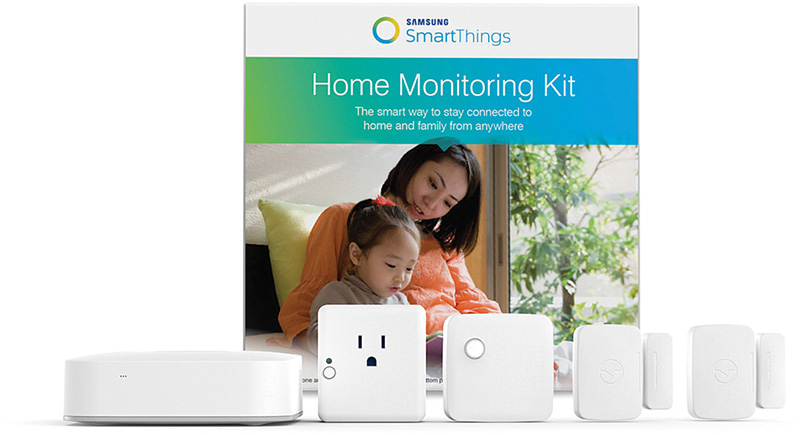
Samsung’s SmartThings Home Monitoring Kit
Here’s what you get in the bundle:
• SmartThings Hub
• SmartThings Motion Sensor
• SmartThings Multipurpose Sensors (2)
• SmartThings Outlet
You can use the motion sensor to alert you to unexpected motion in a given room or area. The multipurpose sensors can monitor whether doors or windows are open or closed. And they all connect to the SmartThings Hub, which can also control other SmartThings devices. Buy this bundle and then purchase additional sensors as needed to protect your entire home. You can even add SmartThings-compatible sirens to complement the alerts you’ll receive on your phone via the SmartThings app.
Learn more at www.smartthings.com.
Wink
Unlike Samsung, Wink doesn’t sell its own sensors and devices (other than the Wink Hub, that is). To use a smart home security system that works with Wink, you need to assemble compatible sensors and devices offered by third parties.
You start with the Wink Hub, of course, and then add a variety of motion sensors and door/window sensors. You can top the whole thing off with an alarm, as well. You can then program the Wink app to sound the alarm and send you an alert when one of the sensors is triggered. (You might want to configure the alert so that it triggers only after a certain time, or when you’re away from home—otherwise, you won’t be able to open a door or window without sounding the alert!)
If you don’t want to assemble your own system from scratch, and don’t yet have a Wink Hub installed, Wink does offer a Security and Monitoring Kit, which sells for around $170. This kit includes the following components:
• Wink Hub
• GoControl Motion Detector
• GoControl Door-Window Sensors (2)
• Levitron DZC Plug-In Appliance Module
These are essentially the same components in Samsung’s competing SmartThings bundle, but they’re from different companies and at a slightly lower cost. If you’re in the Wink ecosystem, this is a good way to get started.
Learn more at www.wink.com.
Canary
If you want simplicity, take a look at Canary. This is an all-in-one indoor security solution—a small table-top device that combines a built-in security camera, various air-quality sensors, and a siren to monitor a given room. If something is amiss, you get an alert on your smartphone. (And the alarm sounds, of course.)
The Canary smart security device
Inside this nifty little device you’ll find
• Security camera with 147-degree wide-angle lens, 1080p HD video, and night vision technology
• Microphone and speaker for two-way communication
• Motion sensor
• Temperature sensor
• Humidity sensor
• Ambient light sensor
• Accelerometer
• 90dB siren
The Canary system connects to your home network via either Wi-Fi or Ethernet. It’s a good solution for a small apartment, and can be supplemented by additional Canary Flex cameras to cover additional rooms in your home.
The basic Canary unit sells for around $200, although Canary sells various packages with additional Canary devices and Canary Flex cameras as well. Learn more at https://canary.is.
Piper
Piper is an all-in-one security device, similar to Canary. This little table-top wonder combines a security camera with a motion sensor and siren, and it sends alerts to the accompanying smartphone app.

The Piper smart security device, along with the Piper smartphone app and optional door/window sensor
Here’s what’s inside each unit:
• Security camera with 180-degree wide-angle lens, night vision (Piper nv only), and pan-and-tilt capability
• Microphone and speaker for two-way communication
• Motion sensor
• Sound sensor
• Temperature sensor
• Humidity sensor
• Light sensor
• 105dB siren
You monitor and control Piper with the Piper smartphone app. It connects to your home network via Wi-Fi and is Z-Wave compatible.
The Piper Classic sells for around $200. The Piper nv, which adds night vision capabilities, sells for around $280. You can augment the basic Piper unit with door/window sensors, smart switches, and the like, if you want.
Learn more at www.getpiper.com.
iSmartAlarm
If you have a larger house and want complete coverage, you need to move beyond the all-in-one devices and invest in a more sophisticated home security package, such as iSmartAlarm, which is an expandable, self-monitored, DIY security system.
The company sells several different kits and some standalone devices. The system is built around the CubeOne hub, which has a built-in 110 dB siren. The CubeOne is the brains of the system, and it alerts you via smartphone or email when there’s been an intrusion.
You can get started with the iSmartAlarm Starter Package. This package includes one CubeOne hub, one motion sensor, one contact sensor, and one remote tag. It sells for around $150.
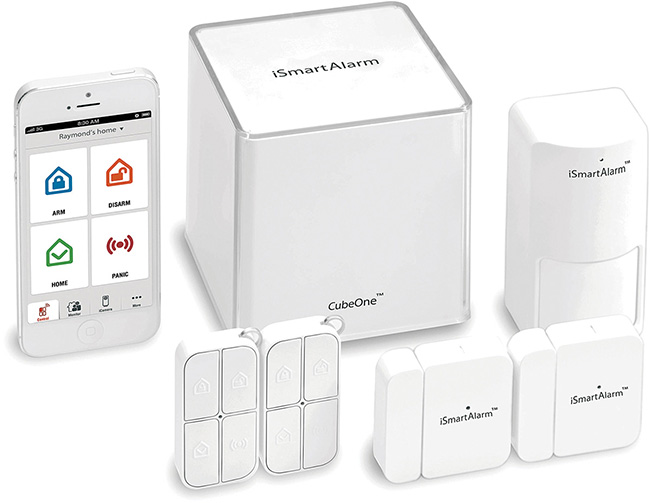
The iSmartAlarm Preferred Package, with accompanying smartphone app
If you need to cover more doors/windows/rooms, consider the Preferred Package. This one gives you one CubeOne hub, one motion sensor, two contact sensors, and two remote tags. It sells for around $200.
iSmartHome also sells additional contact and motion sensors, sirens, and security cameras that link together via the CubeOne hub. Learn more at www.ismartalarm.com.
SimpliSafe
SimpliSafe offers one of my favorite smart home security packages. Unlike iSmartHome, SimpliSafe is a 24/7 monitored solution which provides an added layer of security (at a small monthly cost, of course). Like iSmartHome, there are a variety of packages and devices to choose from.
When a sensor senses that something’s wrong, it wirelessly contacts the SimpliSafe base station. (This unit is the brains of the system and also includes an 85 dB siren.) The base station then sends you an alert and notifies the SimpliSafe support desk, which will contact the appropriate authorities, if necessary.
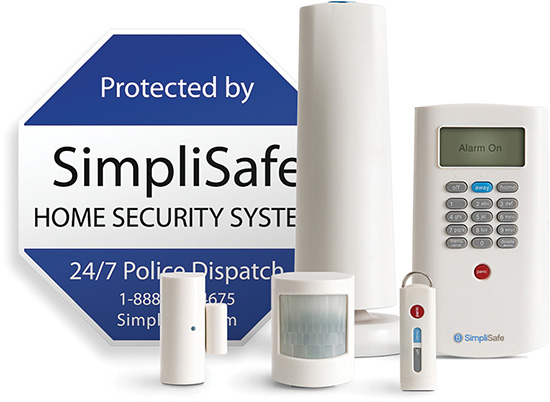
SimpliSafe’s Starter Home Security System
You can build your own system from available components, or go with one of SimpliSafe’s existing packages. A good place to start is the Starter System, which is good for condos and apartments. It includes one base station, one motion sensor, one entry sensor, one wireless keypad, and one keychain remote. It sells for about $230.
For bigger homes, consider the Classic System. This one includes one base station, one motion sensor, three entry sensors, one wireless keyboard, one smoke detector, one extra siren, and one keychain remote. It sells for around $350. (Other systems are available.)
SimpliSafe’s monitoring is done over a cellular connection, so if a bad guy cuts your phone lines it still works. You’ll pay $14.95/month for the monitoring service.
Learn more at www.simplisafe.com.

